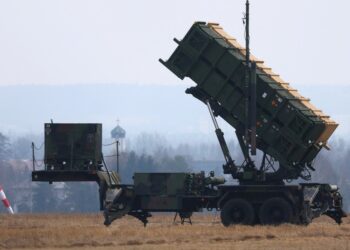WASHINGTON (Realist English). President Donald Trump on Tuesday formally unveiled his long-anticipated homeland missile defense initiative, dubbed “Golden Dome”, a $175 billion project that he says will deliver a next-generation, multi-layered missile shield covering the United States by the end of his second term.
Flanked by Republican senators and senior military officials in the Oval Office, Trump described the system as “state-of-the-art,” integrating land, sea, and space-based assets, including space-based sensors and interceptors capable of neutralizing missile threats launched from anywhere — even from orbit.
“Once completed, the Golden Dome will be the most advanced missile defense system ever built,” Trump declared. “It will protect American lives from threats that were once thought unstoppable.”
Trump has appointed Gen. Michael Guetlein, the U.S. Space Force’s vice chief of space operations, to lead the effort. A veteran of the Missile Defense Agency and former deputy commander of the National Reconnaissance Office, Guetlein is known for streamlining the U.S. space acquisition system during his time at Space Systems Command.
“It is a great day for America,” Guetlein said during the announcement. “Thank you, Mr. President, for trusting us to deliver this critical capability.”
A strategic leap in missile defense
The Golden Dome project builds on Trump’s executive order earlier this year, which called for a 60-day architectural review of options to develop a layered defense system against both conventional and next-generation threats, including hypersonic missiles, cruise missiles, and potential space-launched weapons.
While existing U.S. missile defense is primarily designed to counter threats from rogue states like North Korea and Iran, Trump’s new architecture pivots toward deterring peer adversaries such as China and Russia.
The president confirmed that Canada has agreed to participate in the program, signaling a broader North American defense posture. However, few operational details have been released about system architecture, timelines, or the status of procurement contracts.
Trump’s promise to deliver the full system within two-and-a-half to three years has raised eyebrows in defense circles, especially given that space-based interceptors remain in early conceptual stages, and hypersonic interceptors are not expected to enter service before the mid-2030s.
Despite these challenges, several components are already in development. This includes a satellite-based missile detection layer under the Space Development Agency’s Proliferated Warfighter Space Architecture, which could be adapted to support Golden Dome objectives.
Congressional backing and industrial mobilization
Republican lawmakers have moved swiftly to support the initiative. Senators Dan Sullivan (R-Alaska) and Kevin Cramer (R-N.D.), both present at Tuesday’s event, introduced the Golden Dome Act earlier this year, proposing $19.5 billion in funding for FY2026. Their legislation calls for an expansion of Aegis Ashore sites on U.S. territory and the deployment of aerostat-based threat detection systems.
Meanwhile, the House GOP budget plan for FY2025 earmarks $25 billion for the project — a figure Trump cited approvingly.
Asked whether he expects full congressional support for the $175 billion total cost, Trump appeared confident: “It’s amazing how easy this one is to fund. Some things are tough — but when you say we’re going to save everyone’s lives in a crazy world, it gets very easy.”
While Trump emphasized that all systems would be “made in the U.S.,” he did not confirm the awarding of contracts. Lawmakers highlighted a wide array of defense companies expected to be involved.
Sen. Jim Banks (R-Ind.) cited work by L3Harris on space-based sensors, while Sen. Sullivan mentioned industry giants like Lockheed Martin and RTX (formerly Raytheon Technologies), who are developing ground-based interceptors. Lockheed, notably, won a contract last year to produce the Next Generation Interceptor (NGI).
Sullivan also noted that the project would likely bring in nontraditional defense firms, reflecting a push for innovation in the fast-evolving missile threat landscape.
Strategic ambitions, practical hurdles
Trump’s vision for the Golden Dome is among the most ambitious missile defense undertakings in U.S. history — a scope comparable to the Reagan-era Strategic Defense Initiative. But it faces steep technological and budgetary hurdles.
Experts warn that deploying space-based interceptors, in particular, would require major breakthroughs in sensor fusion, propulsion, and space logistics, as well as significant coordination among the Pentagon, intelligence community, and civilian space agencies.
Still, Trump and his advisers are betting on accelerated timelines, private-sector innovation, and bipartisan support for homeland defense in an increasingly volatile global environment.
Golden Dome marks a bold escalation in U.S. homeland defense planning, blending Cold War-era ambitions with 21st-century technology. While skeptics question the feasibility of delivering space-based interceptors and hypersonic defenses in under three years, the political momentum is real. The project not only aims to deter peer threats but also positions missile defense at the center of America’s strategic posture. Its success — or failure — will likely define the legacy of Trump’s second term in national security.


















